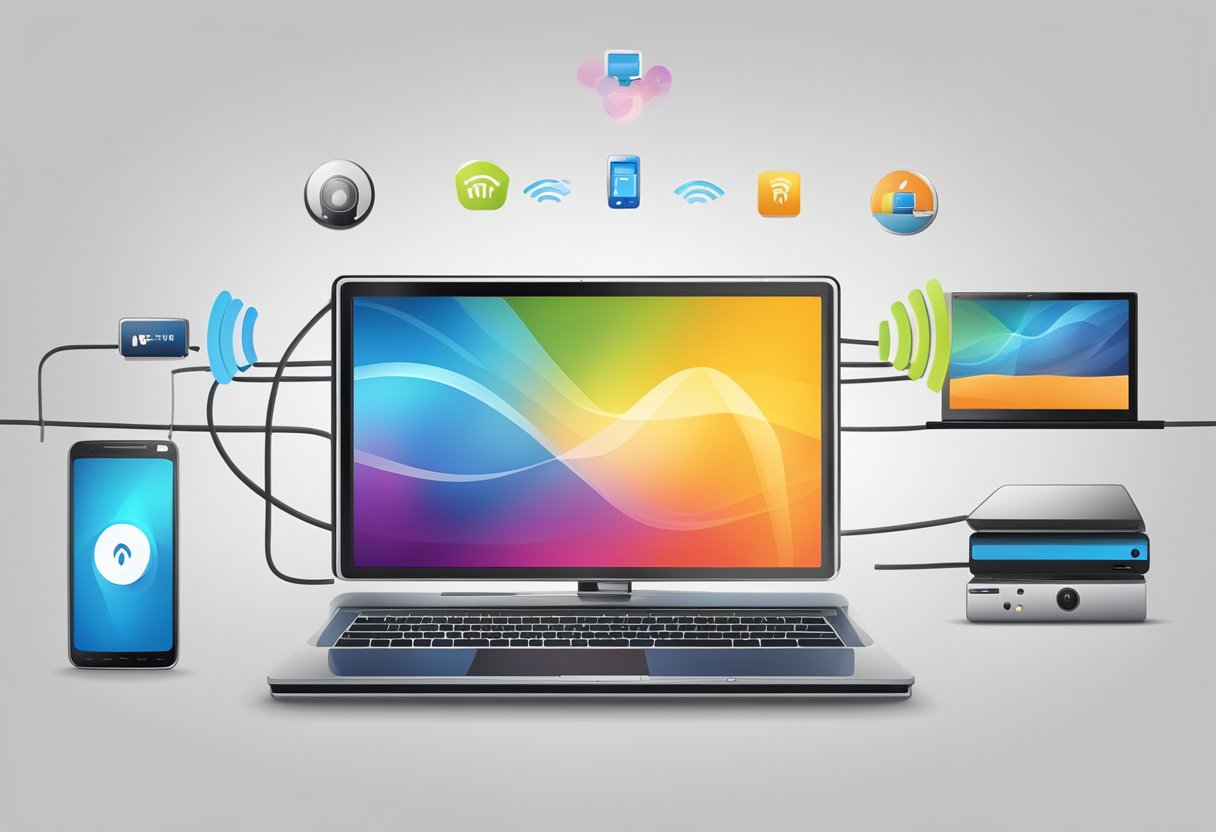What is Internet Streaming? A Clear Explanation

Internet streaming has become an increasingly popular way to access media content in recent years. Streaming is a method of delivering video or audio content such as podcasts over the internet where they can be hosted and accessed, allowing users to watch or listen to their favorite shows, movies, or music without having to download the content first. This technology has revolutionized the way people consume media and has made it easier than ever to access a wide variety of content from anywhere in the world.
Understanding internet streaming requires an understanding of the technology behind it. Streaming works by transmitting data in a continuous flow from a server to a client, allowing the recipient to watch or listen almost immediately without having to wait for a download to complete. Typically, streaming is used for audio and video content, but it can also be used for other types of data such as text or images. Streaming has become the preferred method of accessing internet-based content because it is the quickest means of accessing media content.
Key Takeaways:
- Internet streaming is a method of delivering video or audio content over the internet
- Streaming works by transmitting data in a continuous flow from a server to a client
- Streaming has become the preferred method of accessing internet-based content because it is the quickest means of accessing media content
Understanding Internet Streaming

The Basics of Streaming
Streaming is a method of delivering media content, such as audio and video, over the internet. It works by transmitting data as a continuous flow, allowing the recipient to watch or listen almost immediately without waiting for the content to download completely. This is in contrast to downloading, which requires the entire file to be saved on the user’s device before it can be played.
Streaming media is delivered by a server, which sends the data to the user’s device over the internet. The user’s device then decodes and plays the content in real-time. This process requires a stable internet connection and sufficient bandwidth to support the stream.
One of the advantages of streaming is that it allows users to access media content without having to store large files on their devices. This is particularly useful for users with limited storage capacity on their devices. Streaming also allows users to access a wider range of content, including live events and broadcasts.
Streaming VS Downloading
Streaming and downloading are two different methods of accessing media content over the internet. While streaming transmits data as a continuous flow, downloading requires the entire file to be saved on the user’s device before it can be played.
Downloading has the advantage of allowing users to access content even when they are offline. However, it requires more storage space on the user’s device and can take longer to start playing. Streaming, on the other hand, requires a stable internet connection and sufficient bandwidth to support the stream, but allows users to access content almost immediately without having to wait for the entire file to download.
One of the challenges of streaming is buffering, which occurs when the stream is interrupted due to a slow internet connection or insufficient bandwidth. This can result in a delay before the content begins playing, or in some cases, the stream may stop altogether.
In conclusion, streaming is a popular method of accessing media content over the internet. It allows users to access a wider range of content, including live events and broadcasts, without having to store large files on their devices. However, it requires a stable internet connection and sufficient bandwidth to support the stream, and users may experience buffering if their internet connection is slow or if they have insufficient bandwidth.
Streaming Services and Platforms
With the rise of internet streaming, there are now numerous streaming services and platforms available to consumers. These services and platforms can be broadly categorized into subscription-based services, free streaming options, and live streaming platforms.
Subscription-Based Services
Subscription-based services are the most popular type of streaming service. These services require a monthly or yearly subscription fee and offer a wide range of content to their subscribers. Some of the most popular subscription-based services include Netflix, Stan, Hulu, Disney+, HBO, Apple TV+, Amazon Prime, and Binge.
Netflix is one of the most popular streaming services in the world, offering a vast library of movies and TV shows. Stan is another popular streaming service in Australia, offering a range of TV shows and movies from around the world. Disney+ is a relatively new player in the streaming market, but it has already gained a lot of popularity thanks to its vast library of content from Disney, Pixar, National Geographic, Marvel, and Star Wars.
Free Streaming Options
Free streaming options are also available to consumers, but they typically come with ads. Some of the most popular free streaming options include YouTube, Tubi, and Pluto TV. YouTube is the largest video-sharing platform in the world, offering a wide range of content from music to TV shows to football highlights.
Live Streaming Platforms
Live streaming platforms are becoming increasingly popular, especially for sports fans. Some of the most popular live streaming platforms include Kayo, Foxtel, Optus Sport, and Twitch. Kayo is a popular sports streaming service in Australia, offering live coverage of a wide range of sports, including the NBA, NFL, and football. Twitch is a popular live streaming platform for gamers, allowing them to stream their gameplay to a global audience.
Overall, the streaming market is constantly evolving, with new services and platforms being introduced regularly. As a result, consumers have more choice than ever before when it comes to streaming their favorite TV shows and movies.
Technology Behind Streaming
Streaming technology is the hardware and software that makes it possible to broadcast and watch videos or listen to audio over the internet, live or on-demand. Streaming is the transfer of video, audio, and data so that it’s received in real-time. The technology behind streaming is complex and involves several key components that work together to enable seamless playback of video and audio content.
Content Delivery Networks
Content delivery networks (CDNs) are a critical component of streaming technology. CDNs are a network of servers distributed across various geographic locations that work together to deliver content to users. When a user requests a video or audio file, the CDN identifies the server closest to the user and delivers the content from that server. This ensures that the content is delivered quickly and efficiently, reducing latency and buffering issues.
Compression and Encoding
Video and audio files are often large and take a lot of bandwidth to transmit over the internet. To overcome this issue, streaming services use compression and encoding techniques to reduce the size of the files. This allows for faster transmission of data and reduces the amount of bandwidth required. The most common compression format used for video is H.264, which is supported by most devices and provides high-quality video at a low bitrate.
Adaptive Bitrate Streaming
Adaptive bitrate streaming is a technique used to ensure that the video playback is smooth and uninterrupted, even when the user’s network connection is poor. This technique involves encoding the video at multiple bitrates and resolutions and dynamically adjusting the bitrate based on the user’s network connection. When the network connection is strong, the video is played at a higher bitrate and resolution, providing a better viewing experience. When the network connection is weak, the video is played at a lower bitrate and resolution, ensuring that the playback is smooth and uninterrupted.
In conclusion, streaming technology has revolutionized the way we consume video and audio content. It has made it possible to watch movies and TV shows, listen to music, and play video games in real-time, without the need to download large files. With the increasing popularity of 4K video and the rollout of 5G networks, streaming technology is set to become even more important in the future.
Devices and Connectivity

Compatible Streaming Devices
Internet streaming can be enjoyed on a wide variety of devices, including computers, tablets, and mobile devices. Many modern smart TVs also come with built-in streaming capabilities, allowing users to access content directly from the TV without the need for an external device. Streaming devices such as Chromecast can be used to add streaming capabilities to older TVs.
Different streaming services may have different requirements for compatible devices. For example, some streaming services may require a certain operating system such as Windows or a specific version of a web browser. It is important to check the requirements of the streaming service before subscribing to ensure compatibility with the device being used.
Internet Speed and Quality
The quality of the streaming experience is heavily dependent on the speed and quality of the internet connection. For streaming high-quality content such as 4K videos, a fast and reliable broadband connection is recommended. The recommended internet speed for streaming can vary depending on the type of content being streamed and the number of devices connected to the network.
Some streaming services may also require a subscription fee to access certain content. It is important to consider the cost of the subscription along with the quality and speed of the internet connection before subscribing to a streaming service.
Controller inputs can also affect the streaming experience. Some streaming services may require a game controller or other input device to navigate the content. It is important to check the requirements of the streaming service before subscribing to ensure compatibility with any necessary input devices.
Overall, internet streaming offers a convenient way to access media content on a variety of devices. By considering the requirements of the streaming service and the quality of the internet connection, users can enjoy a high-quality streaming experience.
The Future of Streaming
The future of streaming looks bright as more people turn to streaming services for their entertainment needs. The rise of streaming services has been tremendous, and there are no signs of slowing down. According to ResearchAndMarkets, the video streaming market globally is forecast to reach USD 184.3 billion by 2027.
One of the leading streaming giants is set to maintain its position in the market with its original content. Estimates from Ampere Analysis pose that streaming platforms will be spending more than $23 billion on original content in 2023. This is good news for users who can expect to see more high-quality content on their screens.
Streaming services are not only for movies and TV shows, but they also offer live sports events and music streaming. In the future, we can expect streaming services to offer more real-time streaming of events and concerts. The ability to stream live events in 4K resolution will become more common, providing users with an immersive experience.
One of the challenges that streaming services face is the storage capacity required to store large amounts of video and audio content. However, with advancements in cloud storage, this challenge is becoming less of an issue. Streaming services can now store more content in the cloud, allowing them to offer a wider selection of movies and TV shows.
Streaming services are also changing the way we watch TV. Instead of being tied to a schedule, users can now watch their favorite shows whenever they want. This has led to the rise of binge-watching and shows like Stranger Things that are released all at once.
In conclusion, the future of streaming looks promising with more high-quality content, live events, and real-time streaming. Streaming services will continue to change the way we watch TV and movies, and advancements in cloud storage will allow for more content to be stored and streamed.
Frequently Asked Questions
How does streaming deliver video and audio content over the internet?
Streaming is a way to see or hear content without having to download it. When a user clicks on a video or audio file, the media is sent in small packets over the internet to the user’s device. These packets are received and played in real-time, allowing the user to watch or listen to the content without having to wait for the entire file to download.
What are the differences between streaming and downloading?
The main difference between streaming and downloading is that streaming allows users to view or listen to content in real-time without having to download the entire file beforehand. Downloading, on the other hand, requires the user to wait for the entire file to download before it can be viewed or listened to.
Can you stream content on a television, and if so, how?
Yes, it is possible to stream content on a television. Users can do this by connecting their television to a streaming device, such as a Roku, Apple TV, or Amazon Fire Stick. These devices allow users to access streaming apps and services directly on their television.
What are some popular streaming apps and services available?
There are many popular streaming apps and services available, including Netflix, Hulu, Amazon Prime Video, Disney+, and YouTube TV. These apps and services offer a variety of movies, television shows, and other video content for users to stream.
Is an internet connection required for streaming media?
Yes, an internet connection is required for streaming media. The speed of the internet connection can affect the quality of the streaming experience. Slower internet speeds can result in buffering or poor video quality.
Are there costs associated with using streaming services?
Yes, there are costs associated with using streaming services. Some services require a monthly subscription fee, while others offer both free and paid content. Users should research the costs associated with each service before signing up.
Related content:
Bibliography:
“Global Video Streaming Market 2023-2027” Research and Markets, www.researchandmarkets.com/reports/5513566/global-video-streaming-market-2023-2027. Accessed 1 Apr. 2024.
![logo-new-23[1] logo-new-23[1]](https://agrtech.com.au/wp-content/uploads/elementor/thumbs/logo-new-231-qad2sqbr9f0wlvza81xod18hkirbk9apc0elfhpco4.png)